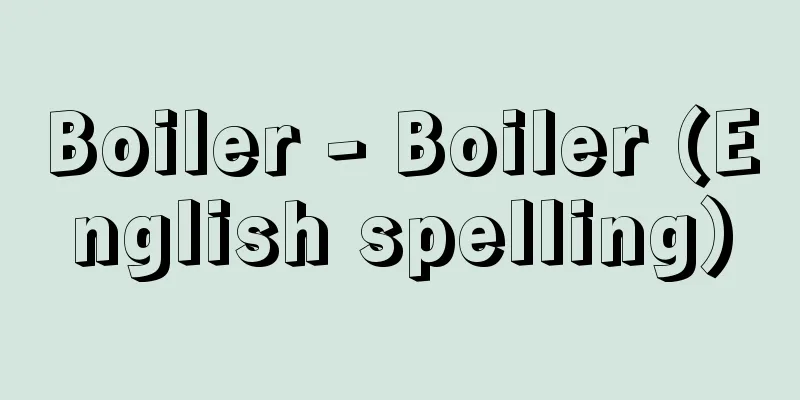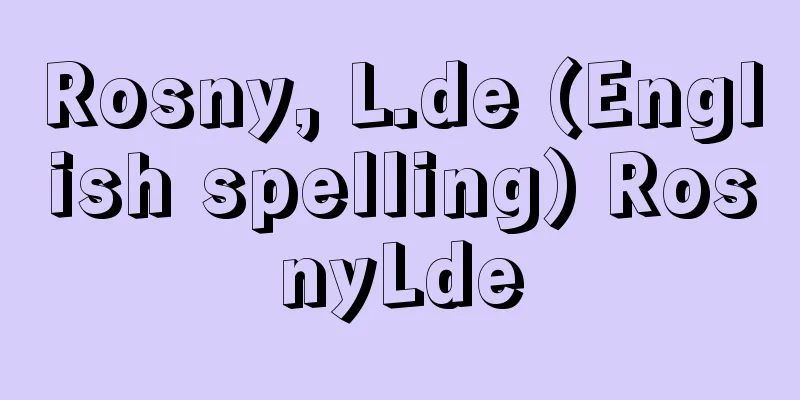Boiler - Boiler (English spelling)

|
A device that transfers the heat of combustion of fuel to water, etc. to generate high-temperature and high-pressure steam. Also called a steam boiler. Used to supply steam to steam engines in thermal power plants and ships, and for work and heating in various factories. The early boilers were fueled by coal, and were hand-fired by manually throwing coal into the grate. Later, stokers, which mechanically fed coal, came into use. Even now in the United States, boilers are used to generate power, generating about 100 tons of steam per hour. In recent years, stokers are also used to incinerate municipal waste. Later, pulverized coal combustion was put into practical use, in which coal is crushed into fine particles and completely burned while suspended in the air. In addition, oil-fired boilers that use heavy oil and in some cases light oil as fuel, and gas-fired boilers that use gas as fuel, have become more common. In recent years, large boilers that use natural gas as fuel have been used in Japanese power plants to purify exhaust gas. In addition, boilers that use waste gas and waste heat from blast furnace gas and coke oven gas in steelworks, heat from nuclear fission in atomic reactors, solar heat, exhaust heat from internal combustion engines, and geothermal heat are also used. Since the end of the 20th century, in response to the need to reduce air pollution and save energy, it has become necessary to improve the efficiency of using low-temperature heat such as exhaust heat, and research is underway to further improve heat transfer efficiency. [Masatake Yoshida] Structure and ClassificationA boiler generally consists of the following parts: (1) The boiler body, which holds water and steam. (2) Fuel combustion devices and furnaces. (3) A superheater that increases the temperature and pressure of the generated steam. (4) A reheater that reheats used steam whose temperature and pressure have been reduced. (5) Economizers and air preheaters that recover and reuse heat from waste gases. (6) Water supply system. (7) Ventilation equipment for combustion. (8) Control devices for efficient operation. There are several ways to classify boilers. Depending on the structure of the main body, they can be divided into round boilers, water tube boilers, and special boilers. Depending on the location of the furnace, they can be classified as internally fired boilers, with the furnace inside the boiler, or externally fired boilers, with the furnace outside the boiler. Also, depending on the method of circulating the boiler water, there are natural circulation types, which circulate the water by density differences, and forced circulation types, which use a pump. [Masatake Yoshida] Round boilerA boiler that has a large diameter drum that holds water and steam, and a thick tube (furnace) or thin tube (smoke tube) through which the combustion gas passes. Because the drum has a large diameter, it cannot be used at very high pressures, up to about 15 atmospheres of gauge pressure (pressure above atmospheric pressure). Round boilers are further divided into vertical boilers, flue-tube boilers, smoke-tube boilers, and flue-tube and smoke-tube boilers. (1) Vertical boiler: A type with a furnace beneath an upright drum. There are two types: the horizontal-tube type, in which several water tubes run horizontally inside the furnace, and the multi-tube type, in which smoke tubes run vertically inside the drum. They have a simple structure, low cost, and are easy to install and use. Efficiency was low at around 50%, but has reached around 80% in recent years. They are used as small boilers in factories and civil engineering construction sites, with an operating pressure of 10 atmospheres or less and an evaporation rate of around 500 kilograms per hour. (2) Flame Tube Boiler This type has a large flue tube that runs axially through a large diameter drum placed to the side. There are Cornish boilers, which have one flue tube, and Lancashire boilers, which have two or more. They are built to be sturdy, as the joints of the flue tube, which burns the fuel, expand with heat. There is little fluctuation in steam pressure and they are easy to clean, but the heat transfer area (the area that transfers heat to water) is small compared to the overall size, so the amount of evaporation is also small, and the efficiency is less than 60%, so they are not manufactured in recent years. The gauge pressure is less than 12 atmospheres, and the evaporation amount is less than 3 tons per hour for the Lancashire boiler. They were often used in factories. (3) Smoke-tube boiler: A large number of smoke tubes through which the combustion gas passes are installed beneath the water surface of a drum placed to the side, increasing the heat transfer area. The start-up time is relatively short, and the amount of evaporation is large for its size, with an efficiency of 60-70%. It is often used in factories and for heating purposes where the gauge pressure is below 10 atmospheres. There are internally fired and externally fired types with a furnace under the drum. In the case of the externally fired type, the heat transfer area is 10-160 square meters, and the evaporation rate is about 15 kilograms to 4 tons per hour. The boilers of steam locomotives are also of this type, but since the diameter of the drum is limited, it is long and narrow and ventilation is poor, so forced ventilation is performed using an ejector that uses the ejection of waste steam. Because the diameter is small, the gauge pressure is limited to about 20 atmospheres. (4) Fire-tube boiler A relatively thin drum is penetrated by a fire tube and numerous smoke tubes around it. The combustion gas that passes through the fire tube is reversed and passes through the smoke tubes to be heated again. The large number of smoke tubes makes cleaning difficult, but the amount of evaporation is large given its size, and efficiency is high. In recent years, an improved type has come into use in which the combustion gas is reversed once inside a large fire tube and then reversed once more through the smoke tube. The temperature distribution inside the fire tube is uniform, the heat is large, and large capacity can be achieved. The amount of evaporation is 18 tons per hour when fired with oil, and less than 25 tons when fired with gas, with an efficiency of 90%. Scotch boilers for ships are also a type of fire-tube boiler, and have three or four fire tubes and many smoke tubes on a thick, short drum. [Masatake Yoshida] Water Tube BoilerIt generates steam by lining up many thin water tubes through which water flows and passing combustion gas at right angles or parallel to the water tubes. Since it mainly uses small diameter tubes, it can withstand high pressure, has a large heat transfer surface area, and has a combination of downcomer tubes that send water down from above and evaporator tubes that generate steam, which allows for good circulation of boiler water and a large amount of evaporation, making it suitable for large-capacity boilers with high temperatures and pressures. It is difficult to clean the water tubes, so good quality water without impurities is required. There are natural circulation boilers, forced circulation boilers using a pump, and once-through boilers, which heat water by pouring it into one end of a long tube and obtaining high-temperature steam without moisture from the other end. [1] Natural circulation water tube boilers Depending on the shape of the water tubes, they are classified into straight tube type, curved tube type, and radiant boiler with mainly water-cooled tubes in the water-cooled wall. (1) There are three types of straight tube water tube boilers: horizontal water tube type, oblique water tube type, and vertical water tube type. In the horizontal water tube type, the upper steam-water drum and the header are connected with a group of water tubes at 15 degrees from the horizontal, and the water flows regularly toward the steam-water drum. Babcock boilers and combination boilers are typical examples. The oblique water tube type is a type invented by Takuma Tsunekichi, in which the upper steam-water drum and the lower water drum are connected with a group of water tubes at 45 degrees with a downcomer inside. The horizontal and oblique water tube types were widely used because they are easy to clean, but are rarely used nowadays. In the vertical water tube type, many evaporator tubes are arranged in a cylindrical shape between the upper steam drum and the lower header, and a downcomer is installed on the outside. Its efficiency is high at about 85%, and it is used as a small, low-pressure boiler with a gauge pressure of 10 atm and an evaporation rate of 2 tons per hour or less. (2) The curved water tube boiler is a type in which an upper steam-water drum and one to three lower water drums are connected by curved water tubes that can be arranged freely, and an internal furnace with good combustion efficiency is installed inside the water tube group. It has a gauge pressure of 130 atm and an evaporation rate of 400 tons per hour or less, and is used in medium-sized factories and industrial facilities. Depending on the arrangement of the water tubes, there are D-type arrangements in which each vertically arranged steam-water drum and water drum are connected by a water tube group and some of the water tubes are used as water cooling tubes for the furnace wall, A-type arrangements in which a water tube group is arranged between the upper steam-water drum and two water drums and is used for an evaporation rate of 10 tons per hour, and single drum arrangements in which a large-diameter downcomer is lowered from the upper steam-water drum to the outside of the furnace and connected to the header, and evaporation is performed with a water-cooled wall and S-shaped evaporation tubes. Its efficiency is high, reaching 85%. (3) In a radiant boiler, almost all of the water tubes form a water-cooled wall, and heat is transferred as radiant heat like an infrared stove, rather than through contact with the combustion gas. Most large boilers with an evaporation rate of 1,000 tons per hour or more are of this type, with a gauge pressure of 200 atmospheres and a steam temperature of close to 600°C. Because of the high pressure, the density difference between water and steam is small, making circulation difficult, so the furnace is made 40 meters high or higher, and several thick downcomer pipes are lowered from the steam drum to the header outside the furnace to allow circulation. [2] Forced circulation boiler This type uses a pump to circulate water, which becomes difficult when the water pressure increases, and has the advantage of allowing more freedom in the arrangement of water tubes. There are Lamont boilers and Velox boilers. (1) Lamont boilers use a circulation pump to forcibly send water to many downcomers. In order to make the amount of water in the water tubes uniform, a Lamont nozzle consisting of a small hole (orifice) is provided at the joint between the water tube and the header. It is a single drum type with a gauge pressure of 110 atmospheres, a steam temperature of 530°C, and an evaporation rate of about 85 tons per hour. In addition, a forced circulation type radiant boiler can reach 200 atmospheres, 570°C, and more than 2,000 tons per hour. (2) Velox boilers are equipped with a water circulation pump and a gas turbine-driven air compressor. Since a large amount of fuel is burned by the compressed air, it generates about 25 times the heat per unit volume of a normal boiler. Therefore, it is smaller and lighter than a normal boiler for the same performance, and the start-up time is only about 6 minutes. [3] Once-through boiler Steam is produced in long tubes, so it is suitable for supercritical boilers above the critical pressure (the maximum pressure at which evaporation occurs. At pressures higher than this, water does not evaporate but turns directly into steam). There are Benson boilers and Sulzer boilers. (1) Early Benson boilers had headers in the middle of the tubes, which repeatedly merged and separated the water, causing it to rise and fall inside the furnace, but the current system has water rising in a spiral up the furnace wall. Supercritical boilers with a gauge pressure of 350 atmospheres, steam temperature of 620°C, and evaporation rate of over 2,500 tons per hour are also being manufactured. Similar boilers include the UP boiler and the FW boiler. In the UP boiler, only the upward flow passes through the furnace wall tubes, and grooves are cut into the inner surface of the tubes to prevent burning. In the FW boiler, the furnace wall tubes, which also have an upward flow, are divided into many groups, and the fluid is mixed between each group. (2) Sulzer boilers consist of one or several long water tubes with no headers in between, and are also called monotube boilers. They are available as supercritical boilers with a gauge pressure of 350 atmospheres, a steam temperature of 650°C, and an evaporation rate of over 2,500 tons per hour. An improved version is the combined circulation boiler, which combines the advantages of both once-through and forced circulation boilers, and when the evaporation rate is low, some of the water is circulated to cool the furnace walls. Fully automatic once-through boilers with an evaporation rate of less than a few tons are used in factories, hospitals, construction sites, etc. [Masatake Yoshida] Special boilerBoilers that have a different heat source, heating method, fluid, etc. from ordinary boilers include indirect heating boilers, waste heat boilers, special fuel boilers, special fluid boilers, electric boilers, and hot water boilers. [1] Indirect heating boiler Also called a double evaporator boiler. A boiler designed to save water supply, typical examples are the Schmidt boiler and the Leffler boiler. (1) In a Schmidt boiler, the steam-water drum of the secondary boiler is placed on top of a water tube boiler (primary boiler) that uses pure water, and the steam from the primary boiler is passed through a tube that runs through the drum to evaporate the water. The steam from the primary boiler is returned to the furnace and used repeatedly. There are small indirect heating once-through boilers that use the same principle but use a once-through boiler as the primary boiler, and have an efficiency of up to 90%. (2) In a Leffler boiler, steam generated in the steam-water drum outside the furnace is led to the furnace to be turned into superheated steam, some of which is used to generate steam for the steam-water drum and the rest is used for the boiler. [2] Waste heat boiler: The heat source is the waste gas from an internal combustion engine or other furnace. Most of these are water-tube boilers, but measures are required to deal with the corrosiveness of high-temperature gas and the wastewater. [3] Special fuel boilers These burn non-standard fuels such as wood chips, municipal waste, carbon monoxide gas from oil refineries, and waste liquid from pulp factories. When there is a shortage of heat, gas or heavy oil is used as supplementary fuel. Wood chips are mainly burned manually using fixed grates, but the mechanization of supply is progressing. Various types of stokers are used for municipal waste, but strict control of the combustion temperature is required to prevent odors and the generation of harmful gases. [4] Special fluid boilers These are used to adjust the composition of synthetic fluids such as dowsam to reduce the pressure of saturated steam that evaporates at high temperatures. In recent years, fluorocarbons have also been used in boilers that use waste gas. Mercury boilers, which use both mercury and water according to the temperature range, were once used, but they are no longer used due to the advancement of regular boilers. [5] Electric boilers These use surplus electricity to produce steam and hot water for work and heating. They are small vertical boilers that use heat rays or electricity directly passed through water to heat it. They can be as efficient as 95% and have an extremely short start-up time. [6] Hot water boiler A boiler that produces hot water for heating, etc. Once-through type is used. [Masatake Yoshida] [References] | | | |©Shogakukan "> Main types of boilers Source: Shogakukan Encyclopedia Nipponica About Encyclopedia Nipponica Information | Legend |
|
燃料の燃焼熱を水などに伝えて、温度・圧力の高い蒸気を発生させる装置。蒸気ボイラーともいう。火力発電所や船舶などの蒸気機関、各種工場の作業用や暖房用などに蒸気を供給するのに使用する。 初期のボイラーは石炭を燃料とし、人力で火格子に投げ込む手焚(だ)きであった。ついで石炭を機械的に供給するストーカー(給炭機)が使われるようになった。現在もアメリカでは、蒸気の発生量が毎時100トン程度の発電用に用いられている。また、近年の都市ごみの焼却もストーカーで行われている。その後、石炭を微粒子状に粉砕し、空気中に浮遊する状態で完全燃焼させる微粉炭燃焼が実用化された。さらに、重油や一部には軽油を燃料とする油焚きボイラー、ガスを燃料とするガス焚きボイラーが多くなった。日本の発電所では近年、排気浄化のために天然ガスを燃料とする大型ボイラーが使用されている。そのほか、製鉄所の高炉ガス・コークス炉ガスの廃ガスや廃熱、原子炉の核分裂の熱、太陽熱、内燃機関の排熱、地熱などを熱源とするボイラーも使われている。20世紀末ごろから大気汚染低減と省エネルギーに対応して、排熱等の低温の熱の利用効率を高める必要があり、一段と伝熱効率を高める研究が進められている。 [吉田正武] 構造と分類ボイラーは一般的に以下の部分から構成される。 (1)水と蒸気を入れるボイラー本体。 (2)燃料の燃焼装置と火炉。 (3)発生した蒸気の温度と圧力を高める過熱器。 (4)温度と圧力の低くなった使用済みの蒸気を再度加熱する再熱器。 (5)廃ガスの熱を回収し再利用する節炭器と空気予熱器。 (6)給水装置。 (7)燃焼用の通風装置。 (8)効率よく運転するための制御装置。 分類にはいくつかの方法がある。本体の構造によって、丸ボイラー(円胴ボイラー)、水管ボイラー、特殊ボイラーに分けられる。炉の位置によれば、ボイラーの中に炉がある内焚きボイラー、外に炉がある外焚きボイラーに分類できる。また、ボイラー水の循環方式から、密度差によって循環する自然循環式と、ポンプによる強制循環式の別がある。 [吉田正武] 丸ボイラー水と蒸気の入る径の大きなドラムを、燃焼ガスの通る太い筒(炉筒)か細い管(煙管)が貫いているボイラー。ドラムの径が大きいので、あまり高い圧力では使用できず、ゲージ圧(大気以上の圧力)で15気圧程度までである。丸ボイラーはさらに、立てボイラー、炉筒ボイラー、煙管ボイラー、炉筒煙管ボイラーに分けられる。 (1)立てボイラー 立てたドラムの下に炉のある型式。炉の中に横に数本の水管を通す横管(よこかん)式と、ドラムの中に縦に煙管を通す多管式がある。構造が簡単で価格が安く、据え付けも取扱いも容易である。効率は50%程度と低かったが、近年は80%程度に達している。使用圧力はゲージ圧10気圧以下、蒸発量毎時500キログラム程度の小型ボイラーとして工場、土木建設現場で使われている。 (2)炉筒ボイラー 横に置いた直径の大きなドラムを軸方向に貫く大きな炉筒を設けた型式。炉筒が1個のコルニッシュボイラーと、2個以上のランカシャーボイラーがある。燃料を燃焼させる炉筒の継ぎ目が熱で膨張するので、頑丈につくられる。蒸気圧力の変動が少なく、掃除も簡単だが、伝熱面積(熱を水に伝える面積)が全体の大きさの割に狭いので蒸発量も少なく、効率は60%以下なので近年では製作されていない。ゲージ圧12気圧以下、蒸発量はランカシャーボイラーの場合毎時3トン以下。工場用に多く用いられた。 (3)煙管ボイラー 横に置いたドラムの水面下に燃焼ガスの通る煙管を多数設けて伝熱面積を大きくしている。始動時間が比較的短く、大きさの割に蒸発量が多く、効率も60~70%に達する。ゲージ圧10気圧以下の工場用、暖房用として多く用いられた。内焚き式と、ドラムの下に炉のある外焚き式があり、外焚き式の場合、伝熱面積10~160平方メートル、蒸発量毎時15キログラム~4トン程度である。蒸気機関車のボイラーもこの型式であるが、ドラムの径に制限があるので細長くて通風が悪く、廃蒸気の噴出を利用したエゼクターで強制通風している。径が細いので、ゲージ圧20気圧程度が限度である。 (4)炉筒煙管ボイラー 比較的細いドラムを炉筒とその周辺の多数の煙管が貫通し、炉筒を通った燃焼ガスは反転して煙管を通り、ふたたび加熱する。煙管の数が多いので掃除は困難だが、大きさの割に蒸発量が多く、効率も高い。近年は大きな炉筒の中で燃焼ガスを一度反転させ、さらにもう一度煙管で反転させる改良型が使われるようになった。炉筒内の温度分布が均一で熱量も多く、大容量化が可能である。蒸発量は油焚きで毎時18トン、ガス焚きで25トン以下で、効率は90%に達する。船舶用のスコッチボイラーも炉筒煙管ボイラーの一種で、太く短いドラムに3~4本の炉筒と多くの煙管を備えている。 [吉田正武] 水管ボイラー水の通る細い水管を多数並べ、水管と直角か平行に燃焼ガスを通して蒸気を発生させる。小径の管が主体なので高圧に耐えること、伝熱面積を広くできること、水を上から下ろす降水管と蒸気を発生させる蒸発管の組合せでボイラー水の循環がよく、蒸発量が多いことなどから、高温・高圧の大容量ボイラーに向いている。水管の掃除が困難なので不純物のない良質の水が必要である。自然循環式、ポンプによる強制循環式、長い管の一端から水を入れて加熱し、他端から水分のない高温蒸気を得る貫流ボイラーがある。 〔1〕自然循環式水管ボイラー 水管の形によって直管式と曲管式、水冷壁の水冷管を主とする放射ボイラーに分けられる。(1)直管式水管ボイラーには横水管式、斜め水管式、立て水管式の3種がある。横水管式は、上にある気水ドラムと管寄せを水平から15度の水管群で結び、水は気水ドラムに向かって規則正しく流れる。バブコックボイラー、組合せボイラーが代表的である。斜め水管式は、上の気水ドラムと下の水ドラムを、中に降水管を包み込んだ45度の水管群で連結する、田熊常吉(たくまつねきち)発明の型式である。横・斜め水管式は、掃除が容易で広く使われたが、現在ではほとんど使用されていない。立て水管式は、上部の蒸気ドラムと下部の管寄せの間に多数の蒸発管を円筒状に配列し、その外側に降水管を設ける。効率は85%程度と高く、ゲージ圧10気圧・蒸発量毎時2トン以下の小型・低圧ボイラーとして使われている。(2)曲管式水管ボイラーは、上部の1個の気水ドラムと下部の1個から3個の水ドラムの間を配置の自由な曲水管で結び、水管群の内側に燃焼効率のよい内焚き炉を設けた型式である。ゲージ圧130気圧・蒸発量毎時400トン以下で、中型までの工場、産業用に使用される。水管の配置により、垂直に配した各1個の気水ドラムと水ドラムを水管群でつなぎ、一部の水管を炉壁の水冷管とするD形配置、上の気水ドラムと2個の水ドラムの間に水管群を配して蒸発量毎時10トンで使われるA形配置、上部の気水ドラムから炉外に大口径の降水管を下ろして管寄せと結び、水冷壁とS形の蒸発管で蒸発させる単ドラム配置がある。効率は高く85%に達する。(3)放射ボイラーは、水管のほとんど全部で水冷壁を構成し、熱は燃焼ガスとの接触ではなく赤外線ストーブのように放射熱として伝える。蒸発量毎時1000トン以上の大型ではほとんどがこの型式で、ゲージ圧200気圧、蒸気の温度は600℃に近い。高圧のため水と蒸気の密度差が小さく循環が困難なので、炉の高さを40メートル以上にし、蒸気ドラムから炉外に数本の太い降水管を管寄せまで下ろして循環させている。 〔2〕強制循環式ボイラー 高圧になると悪くなる水の循環をポンプで行う型式で、水管の配置が自由になる利点がある。ラモントボイラーとベロックスボイラーがある。(1)ラモントボイラーは、循環ポンプで多数の降水管に強制的に水を送る。水管の水量を均一にするために、水管と管寄せの結合部に小さな穴(オリフィス)で構成されたラモントノズルを設けてある。単ドラム型式で、ゲージ圧110気圧、蒸気温度530℃、蒸発量毎時85トン程度。また、放射ボイラーを強制循環式としたものは200気圧、570℃、毎時2000トン以上に達する。(2)ベロックスボイラーは、水の循環ポンプとともにガスタービン駆動の空気圧縮機を備えている。圧送される空気によって多くの燃料を燃焼させるので、単位体積当り普通のボイラーの25倍ほどの熱を発生する。したがって同一の性能に対しては小型・軽量で、始動時間も6分程度ですむ。 〔3〕貫流ボイラー 長い管の中で蒸気にするので、臨界圧(蒸発のおこる限界の圧力。これ以上の圧力では水は蒸発せずに直接蒸気になる)以上の超臨界ボイラーに向いている。ベンソンボイラーとズルツァーボイラーがある。(1)ベンソンボイラーは、初期の型は管の途中に管寄せを配置して水の合流と分流を繰り返し、炉の中を水が上昇下降していたが、現在は水が炉壁を螺旋(らせん)状に上昇する方式である。ゲージ圧力350気圧、蒸気温度620℃、蒸発量毎時2500トン以上の超臨界ボイラーもつくられている。類似のボイラーに、UPボイラーとFWボイラーがある。UPボイラーは、炉壁管を上昇流だけが通り、管の内面に溝を切って焼損を防いでいる。FWボイラーは、やはり上昇流の炉壁管を多くのグループに分け、各グループ間で流体を混合する。(2)ズルツァーボイラーは、途中に管寄せのない1本または数本の長い水管からなり、モノチューブボイラーともいう。ゲージ圧350気圧、蒸気温度650℃、蒸発量毎時2500トン以上の超臨界ボイラーまである。改良型に、貫流ボイラーと強制循環式ボイラーの利点を備えたコンバインド・サーキュレーションボイラーがあって、蒸発量の少ないときには一部の水を循環させて炉壁の冷却にあてている。また、蒸発量数トン以下の全自動貫流ボイラーは工場、病院、建設現場などで用いられている。 [吉田正武] 特殊ボイラー熱源、加熱方法、流体などが普通と異なるボイラーで、間接加熱ボイラー、廃熱ボイラー、特殊燃料ボイラー、特殊流体ボイラー、電気ボイラー、温水ボイラーがある。 〔1〕間接加熱ボイラー 二重蒸発ボイラーともいう。供給する水を節約する目的のボイラーで、シュミットボイラー、レフラーボイラーが代表的である。(1)シュミットボイラーは、純水を使用する水管ボイラー(一次ボイラー)の上に二次ボイラーの気水ドラムを置き、ドラムを貫く管に一次ボイラーの蒸気を通して水を蒸発させて使用する。一次ボイラーの蒸気は炉に戻って反復して使われる。同じ原理で貫流ボイラーを一次ボイラーとして用いる小型の間接加熱式貫流ボイラーがあり、効率は90%に達する。(2)レフラーボイラーは、炉外の気水ドラムで発生した蒸気を炉に導いて過熱蒸気とし、その一部を気水ドラムの蒸気発生に、残りをボイラーに使用する。 〔2〕廃熱ボイラー 内燃機関やほかの炉の廃気を熱源とする。水管ボイラーが多いが、高温ガスの腐食性や汚水への対策が必要である。 〔3〕特殊燃料ボイラー 木くずや都市ごみ、石油精製で生ずる一酸化炭素ガス、パルプ工場の廃液など、通常の燃料以外を燃焼させる。熱量が不足するときは、補助燃料としてガスや重油を用いる。木くずの場合は固定火格子の手焚きが主だが、供給の機械化が進んでいる。都市ごみには各種ストーカーが使用されているが、悪臭防止や有害ガス発生抑止などのために燃焼温度の厳しい調節が必要である。 〔4〕特殊流体ボイラー ダウサムなどの合成流体の組成を調節して高温度で蒸発する飽和蒸気の圧力を下げるために使われる。近年の廃ガス利用のボイラーにもフロンなどが用いられている。かつては水銀と水を温度範囲にあわせて併用する水銀ボイラーが使用されていたが、通常のボイラーが進歩したので使われていない。 〔5〕電気ボイラー 余剰電力を利用して作業用や暖房用の蒸気・温水をつくる。熱線による加熱か、直接水に電気を通して加熱する小型の立て型ボイラーである。効率は95%にも達し、始動時間もきわめて短い。 〔6〕温水ボイラー 暖房用などの温水をつくるボイラー。貫流型などが使われる。 [吉田正武] [参照項目] | | | |©Shogakukan"> ボイラーのおもな種類 出典 小学館 日本大百科全書(ニッポニカ)日本大百科全書(ニッポニカ)について 情報 | 凡例 |
>>: Wheeler, Sir (Robert Eric) Mortimer
Recommend
Elphinston
1779‐1859 Governor of Bombay under the British Eas...
Stanley Pool
The name given to the area in central Africa where...
Large scale science
...The term was coined by American engineer Alvin...
Hudson Bay - Hudson Bay
A large bay in northeastern Canada. In the broad ...
Savoy
...The family originated in the 11th century with...
Arbour, W. - Arbour
...Since strain C does not have either of these f...
Feast of the Nativity of Saint John the Baptist
The birthday of John the Baptist. June 24th. John ...
Tomobe
[Noun] 1. Before the Ritsuryo system, a group of p...
"Encyclopedia Italiana" - Italiana Encyclopedia
…In 1925, he drafted the Intellectual Manifesto i...
Indecent assault - indecent assault
The crime of committing obscene acts against men a...
Heterogametes - Heterogametes
When gametes combine in the reproduction of livin...
Standard Oil Co. (Ohio) (English name) StandardOilCo
…Not only is it the top oil major in terms of cru...
"Miscellaneous Anatomy Notes"
…An Italian physician. After graduating from the ...
Antonio Buero Vallejo
1916‐2000 Spanish playwright. After the end of the...
Acheiropoietos - Acheiropoietos
…So, in order to justify the image of Christ, sev...









